Congratulations to the winners of our first Space Brain Hack!
We were blown away by the amazing solutions imagined by young Canadians for the first edition of our Space Brain Hack. The theme this year related to mental health. We asked them to think of ways to:
- provide astronauts with sensory simulation and a virtual escape from their work and stressful environment; or
- help them maintain connection with family and friends and with the home planet.
All submissions were evaluated on the basis of four criteria: communication; innovation; validity; and critical thinking/critical analysis. A panel of CSA experts then did a blind review and ranked the top submissions.
Below are short summaries of the top submissions for each category (grades 6 to 8 and grades 9 to 12). Spoiler alert: these summaries do not do justice to the in-depth work done by the participants. As a team or individually, they learned about the life of astronauts in space and mental health, did extensive research, brainstormed, discussed with experts to validate their idea and its feasibility, reflected on how to best adapt it to the space environment, and thought of creative terrestrial applications for their proposed solutions.
Many even went above and beyond what was requested, providing videos and creating prototypes. While these were not assessed, it showed us once again how curious, engaged and creative young Canadians are. You inspire us!
Thank you to all the participants and to the many educators who facilitated the activity. Well done!
And congratulations to everyone whose submission made it to the top, especially our grand prize winners:
- Bhavishyaa from Oakville, Ontario, for PeaceMaker
(grades 6 to 8 category) - Maya from Calgary, Alberta, for Cosmic Companions: Digital Pets in Space
(grades 9 to 12 category)


The grand prize winners of the Space Brain Hack, Bhavi (left) and Maya. (Credit: provided by the families)
The top three winners for each category will be invited to take part in a virtual working session with CSA experts, during which they will present their solution to the experts and the other winners and receive feedback about their idea.
Bhavishyaa and Maya win a virtual visit from a CSA expert or astronaut.
We can't wait to see what young Canadians will imagine in the next edition of the Space Brain Hack! Details and the theme will be announced in the fall. Stay tuned!
Note: The drawings appear in the language in which they were submitted.
Grades 6 to 8
FIRST PLACE: PeaceMaker
Bhavishyaa
Grade 6
Oakville, Ontario
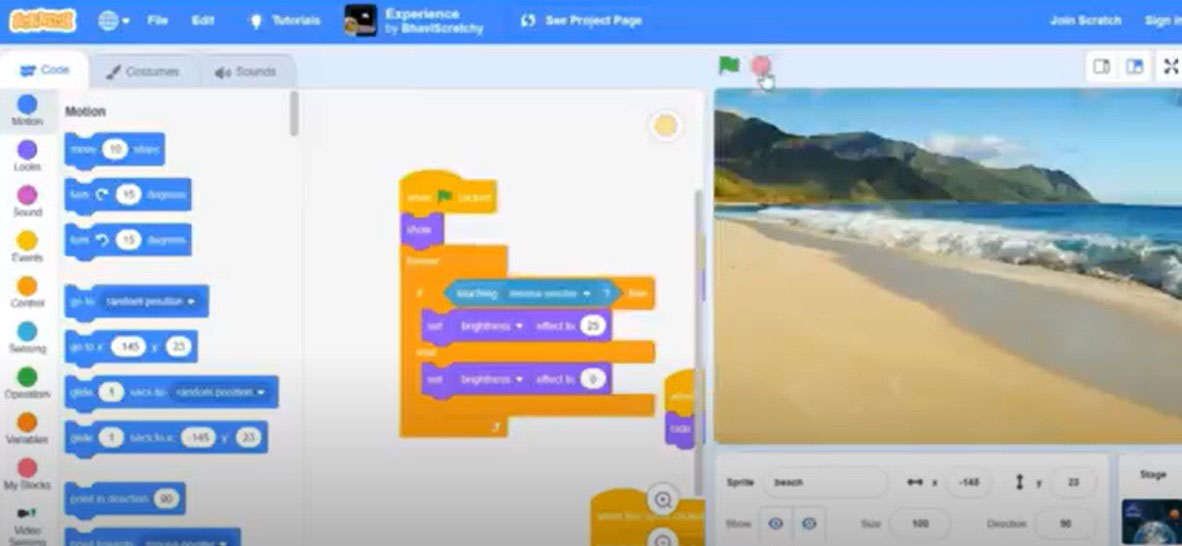
Bhavishyaa proposes a VR headset that includes stereo sound, detection gloves and preprogrammed places on Earth that the astronaut is fond of. The headset would also use brain wave analysis to monitor the astronaut's emotions and automatically change the setting to relax their mind if required. The technology could be adapted for people who are struggling during periods of isolation (e.g. snowstorms, seasonal changes, viruses).
SECOND PLACE: Comical mission
Lea, Lily and their colleagues
Grade 6
Bibliothèque Georges-Brossard/Maison des jeunes de Saint-Bruno
Saint-Bruno-de-Montarville, Quebec
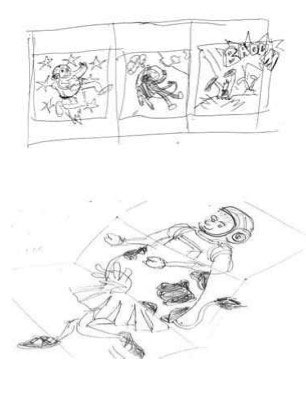
This solution is based on a game called "exquisite corpse." It aims to make astronauts feel less lonely through the use of communication and game apps, and will bring lots of fun to their daily lives. The proposed games feature drawings and stories that are zany, unexpected, magical and hilarious. Players will participate in comic jams, complete stories without knowing the beginning, and rearrange famous characters cut into three interchangeable parts (head, torso, legs)! These games can be played initially by the astronauts and their family and friends, but can then be opened up to everyone. That way, the public will able to follow along on the space journey while providing drawings and stories that alleviate the crew's anxiety by making them laugh. The more the merrier!
THIRD PLACE: Telepresence Robot
Areeb
Grade 7
Ottawa, Ontario

Text version:
Redesigned Atlas (telepresence robot)
VR headset
Exoskeleton
The solution proposed combines virtual reality, an exoskeleton and telepresence robots. This will allow astronauts to "physically" interact with people on Earth, helping maintain their social and physical connections with family and friends. The robot could perform a wide range of actions, and have sensors to give it human-like senses and touch. Its movements would be controlled by an exoskeleton donned by the astronaut in space and have a screen on its face to project the astronaut's face, allowing more personal interactions. A VR headset would allow the astronaut's facial reaction to be projected onto the robot's screen face and receiving feedback as well.
4 – Multi Task Mutt
Rio, Varana, Anjali
Grade 6
Macville Public School
Bolton, Ontario
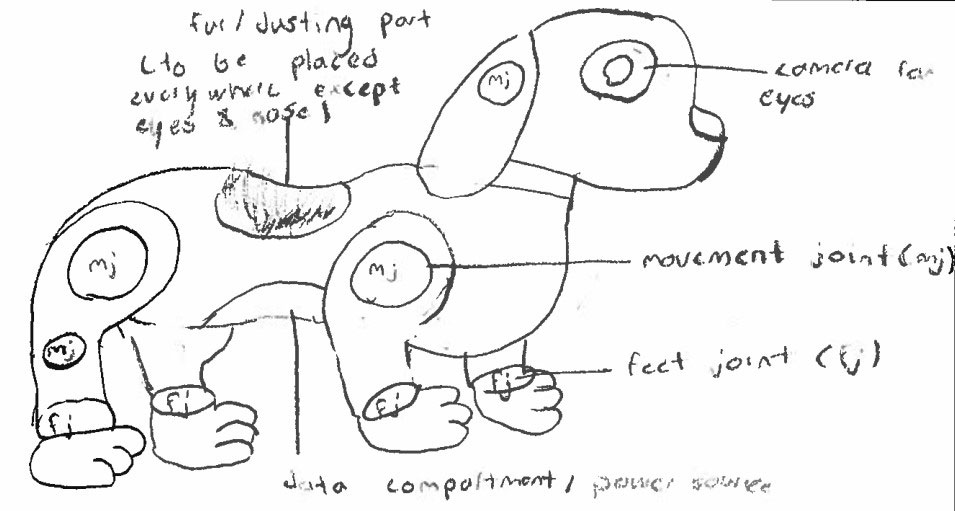
Text version:
Fur/dusting part (to be placed everywhere except eyes and nose)
Camera for eyes
Movement joints (mj)
Feet joints (fj)
Data compartment/power source
Multi Task Mutt is a robotic mental health support dog with fur spots to be pet, but that can also help with chores in space (e.g. vacuuming, dusting, capturing images). The robotic support dog would have its own dedicated magnetic station on board making its presence known and providing comfort to the astronauts. The goal is to make astronauts' daily tasks easier, but also give time to focus on other aspects of their well-being in space.
5 – Mission Sleep
Diya, Samreen, Tamanna
Grade 6
Macville Public School
Bolton, Ontario
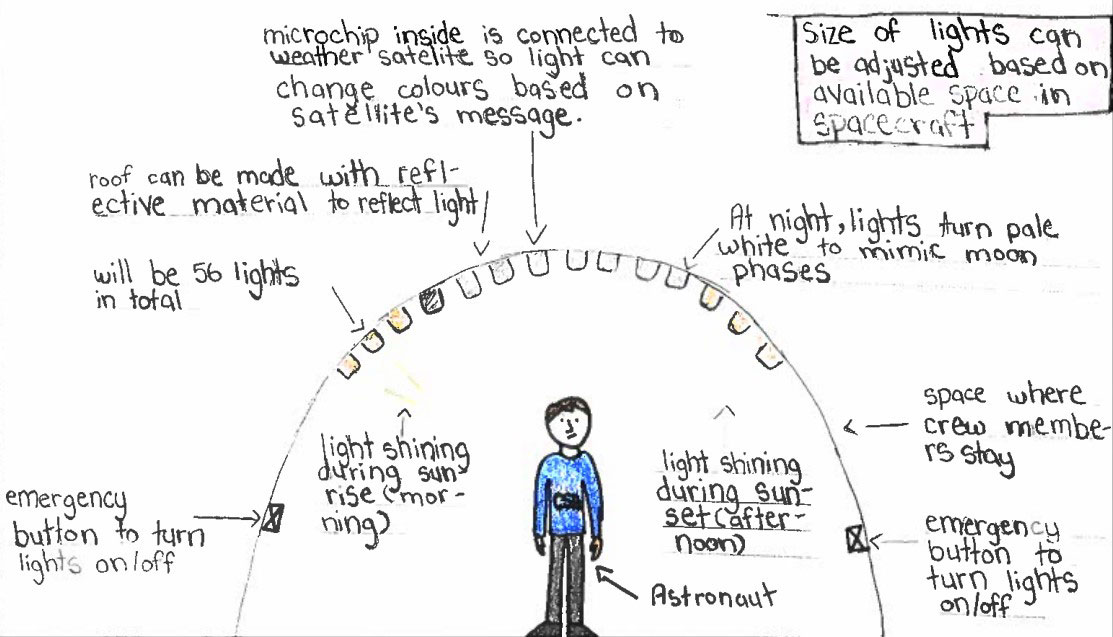
Text version:
Astronaut
Light shining during sunrise (morning)
Light shining during sunset (afternoon)
Size of lights can be adjusted based on available space in spacecraft
Emergency button to run lights on/off (note: there are two emergency buttons on the drawing)
Will be 56 lights in total
Roof can be made with reflective material to reflect light
Microchip inside is connected to weather satellite so light can change colours based on satellite's message
At night, lights turn pale white to mimic Moon phases
Space where crewmembers stay
Emergency button to turn lights on/off (note: there are two emergency buttons on the drawing)
The team proposes using a series of lights that can mimic Earth's rhythms and Moon phases in order to help with astronauts' sleep and circadian rhythms. This device will be programmed to adjust the colour and dimness of the light to the time of day on Earth from where the rocket was launched. The goal of this device is to address the lack of sleep that astronauts may experience during the Artemis missions and on board the Orion spacecraft.
6 – VR Hiking
Parker, Wesley, Isaac
Grade 8
Fisher Park Summit Alternative Public School
Ottawa, Ontario

Text version:
Treadmill
VR headset
In order to simulate a walk or a hike, beautiful landscapes will be displayed in a virtual reality headset while the astronaut is on the treadmill. It will be a very realistic experience that can relieve stress, increase heart rate and improve fitness.
7 – Solar Lamp Therapy
Grace, Ebunoluwa, Olumorewa, Chinemerem, Chikanyima, Randy
Grade 6-7-8
Imhotep's Legacy Academy, Dalhousie University
Halifax, Nova Scotia

This solar light or lamp would help with astronauts' mood, sleep, and mental/emotional health in space. It would mimic sunlight and provide much-needed vitamin D, to regulate astronauts' sleep cycles and inner clock, but also facilitate their rehabilitation when they come back to Earth.
8 – Digital Brain
Harliv and Jaden
Grade 6
Lambeth Public School
London, Ontario
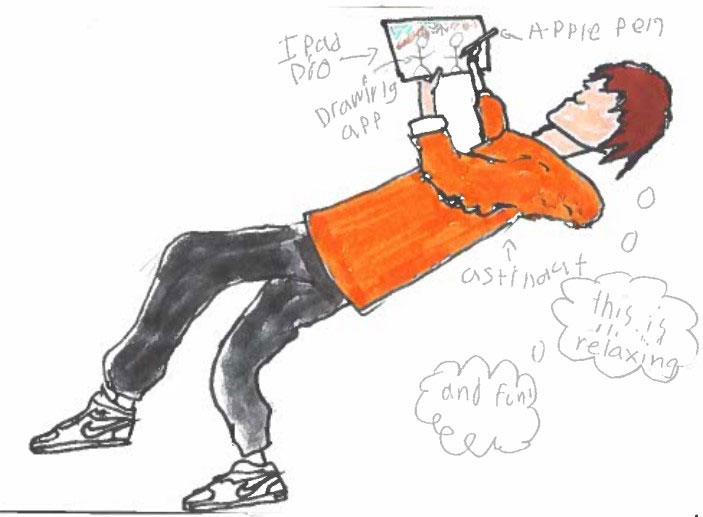
Text version:
Astronaut
Thought bubbles:
- "This is relaxing"
- "And fun"
iPad Pro
Drawing app
Apple pen
This solution encourages astronauts to take part in creative activities such as digital art and drawing to express their emotions through art using a digital pen. Dedicating a couple of hours or more, astronauts can also share their art with fellow crewmembers. Digital art can help with astronauts' stress levels and make them calmer and focus better on their tasks.
9 – Contenant de calme/Calm Crate
Sofie, Hailey, Valeria
Gradev8
Fisher Park Summit Alternative Public School
Ottawa, Ontario
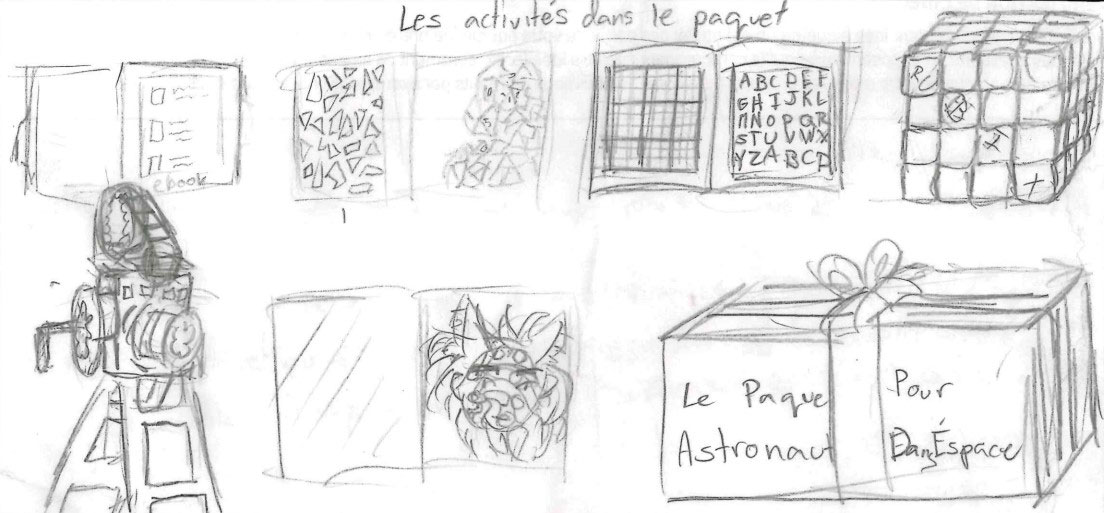
Text version:
Les activités dans le paquet
Le paquet pour astronaute dans l'espace (on the gift box)
Sofie, Hailey, and Valeria propose sending a personalized package to astronauts made up of different calming activities, such as colouring books, and other stimulating activities like a Rubik's cube and engineering activity kits. The goal is to provide astronauts with a variety of ways to spend their time on a daily basis.
10 – Space bicycle
Kien, Jayden, Ariyan, Alex
Grade 8
Fisher Park Summit Alternative Public School
Ottawa, Ontario
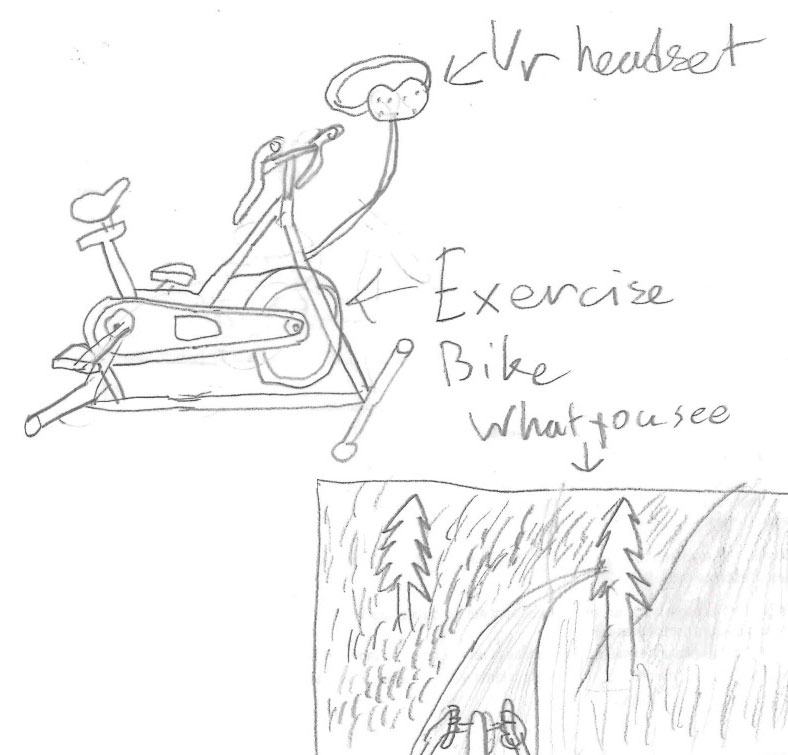
Text version:
VR headset
Exercise bike
What you see
This solution uses virtual reality and a stationary bike to simulate a ride through nature. This solution will enable the user to ride on a bike path and improve their mental health. Music can enhance the experience.
Grades 9 to 12
FIRST PLACE: Cosmic Companions: Digital Pets in Space
Maya
Grade 10
Calgary, Alberta

Text version:
Robotic cat shares similar sensors and features as the robotic dog
Visual sensors – eyes display emotions
Audio sensors
Touch sensors
Movable tail – displays emotions
Movable neck – to nod or shake head
More traditional colours (orange tabby cat)
Customizable colours and features
More colourful and untraditional for a dog
Maya proposes a solution that combines robotics and virtual technology to address issues caused by prolonged isolation and lack of sensory stimuli in space. The digital pets would be an AI assistant for the astronauts who could not only interact with and train their pets to combat boredom, but could also access multimedia content, such as music, movies, documentaries, and audio files that are unique to their preferences. Additionally, the robotic pets could remind the astronauts of important events and tasks.
The use of robotic pets could be beneficial to the well-being and mental health of the elderly or bedridden population, who may experience loneliness and might not have the physical capability or resources to own, feed, walk or care for a real pet. Children with conditions like autism and Down syndrome can benefit from having a non-allergenic robotic pet as it provides comfort and social stimulation.
SECOND PLACE: The Musk of "Nose-talgia"
Sadie
Grade 9
Stittsville, Ontario
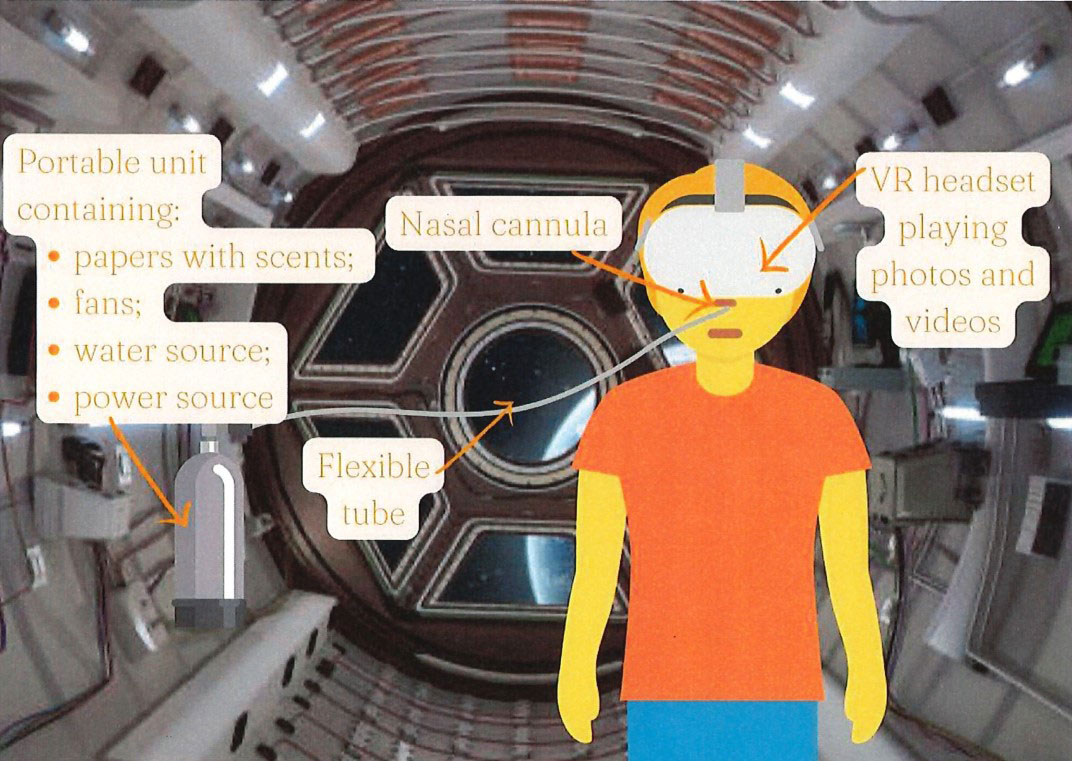
Text version:
Portable unit containing:
- Papers with scents
- Fans
- Water source
- Power source
Nasal cannula
Flexible tube
VR headset playing photos and videos
The sense of smell can trigger memories. Sadie proposes to use scent to unlock positive emotions in astronauts to help maintain their mental wellness while on missions. This would be done using VR headsets with pre-programmed videos and photos from the astronaut's life and technology that would distribute the scents to match the images on the VR headset. The goal is to use scent combined with visual imagery to bring back nostalgia and create a positive enhanced emotional response.
THIRD PLACE: Virtual Reality: Our Solution to Improving Mental Health of Astronauts
Karen
Grade 9
Homeschooled
Calgary, Alberta

Text version:
VR headset
- Headpiece with electrodes and moistening systems
Screen view
- System updates
- Game mode
- Night mode
Virtual reality room
- Padded walls
- VR headset storage
- Harness
- Treadmill
Karen proposes to use a VR system with handheld controllers for astronauts to exercise, play video games with friends, build teamwork, and increase mental stimulation in space. This VR system would require only a small, dedicated space in order to navigate through a digital world. This VR could be motivational, rewarding, and fun for astronauts.
4 – The Journey of Bringing Earth to Space
Maya
Grade 10
Calgary, Alberta
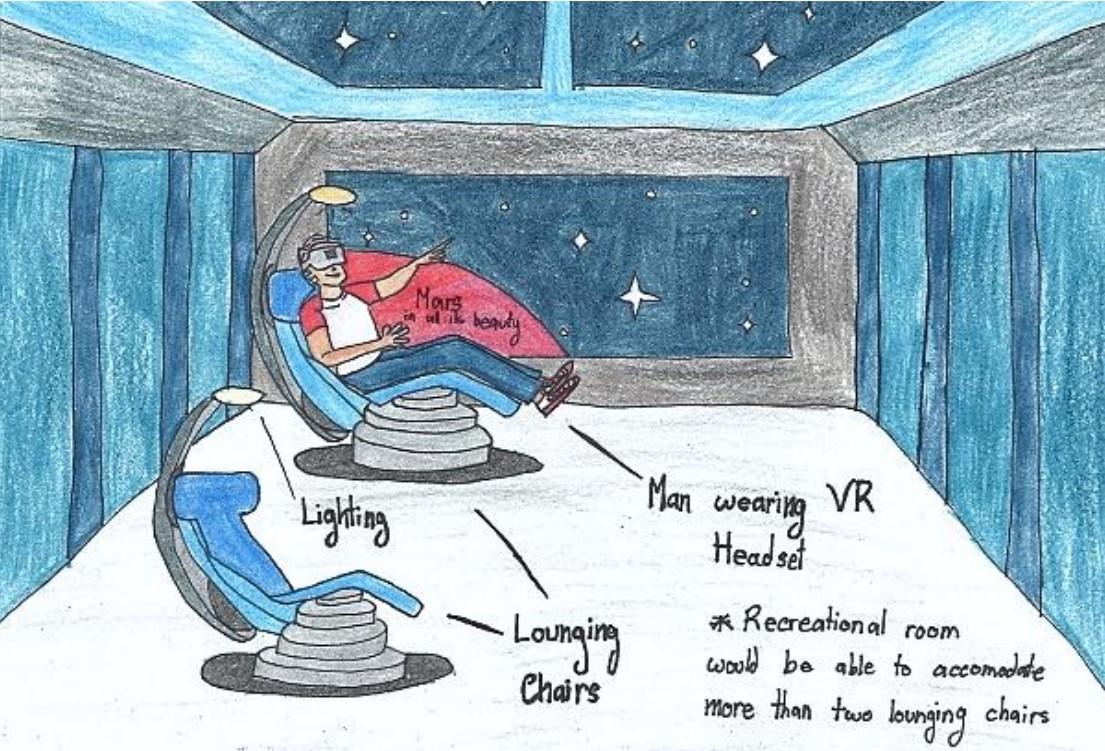
Text version:
Mars in all its beauty
Lounging chairs
Lighting
Man wearing VR headset
Recreational room would be able to accommodate more than two lounging chairs
The solution involves providing personalized digital content based on the astronaut's preferences, such as nature documentaries, relaxation techniques, favourite places, music and art therapy, through a tablet or similar device. A private, customizable recreational room equipped with virtual reality technology could also be created to deliver the same content and make it feel more like home. This VR room would be separate from work and activity areas to avoid mixing work and relaxation periods. It would have noise-cancelling properties, minimal lights to prevent disruptions to the astronaut's circadian rhythm, comfortable lounging chairs, and a specific temperature to ensure comfort.
5 – StellarAI
Shivam
Grade 10
Brampton, Ontario
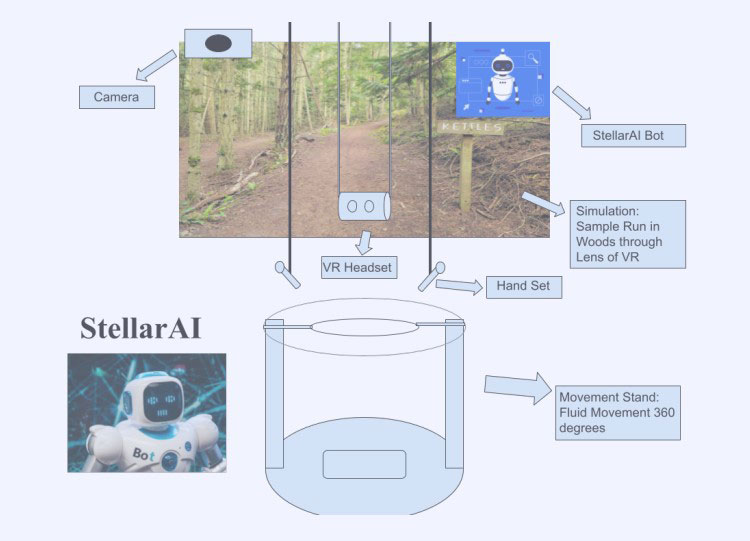
Text version:
StellarAI
StellarAI Bot
Simulation: sample run in woods through lens of VR
Camera
VR headset
Handset
Movement stand: fluid movement 360 degrees
Shivam would like to introduce StellarAI, a virtual reality AI bot to maintain both good mental health and a healthy physique through a virtual 3D space. Astronauts will be able to interact with a fully integrated chatbot that measures stress levels and the mental health of the astronaut. It generates responses and activities for the astronaut to do based on this data. Through the 3D interface, astronauts can also virtually interact with their family on Earth.
StellarAI is trained and equipped with vast amounts of code and a database of information from Earth. It assesses the individual with head, hand and body sensors. It can have a conversation with the user and direct them to a virtual reality experience like going for a run, playing a sport, or speaking with their family based on the diagnostic made.
